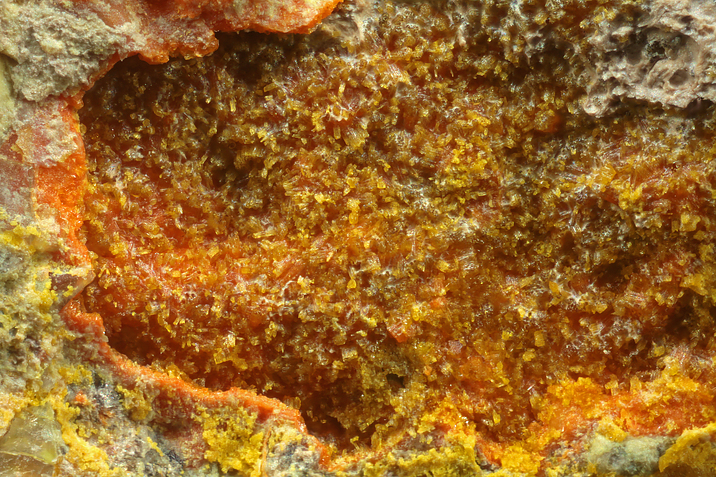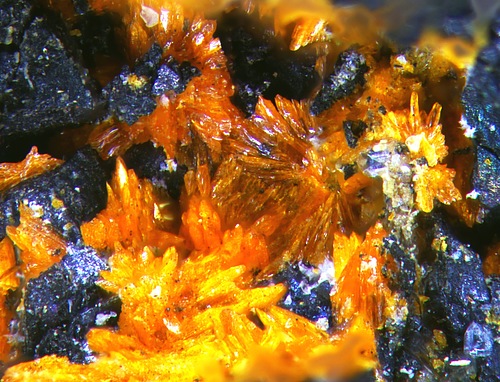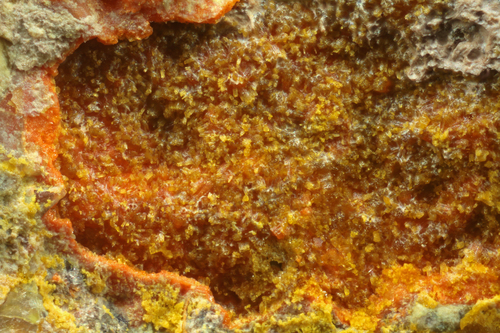Protasite
A valid IMA mineral species
This page is currently not sponsored. Click here to sponsor this page.
About Protasite
Formula:
Ba(UO2)3O3(OH)2 · 3H2O
Colour:
Light orange, bright orange
Lustre:
Sub-Adamantine
Specific Gravity:
5.827 (Calculated)
Crystal System:
Monoclinic
Name:
Named for Professor Jean Protas (1932–2007), French mineralogist, University of Nancy, Nancy, France, who first synthesized the compound, and for his work with uranium oxide minerals.
This page provides mineralogical data about Protasite.
Unique Identifiers
Mindat ID:
3289
Long-form identifier:
mindat:1:1:3289:2
GUID
(UUID V4):
(UUID V4):
ab83edca-a2ea-4b12-a1cb-c785315554b9
Classification of Protasite
Approved
First published:
1986
Type description reference:
4.GB.10
4 : OXIDES (Hydroxides, V[5,6] vanadates, arsenites, antimonites, bismuthites, sulfites, selenites, tellurites, iodates)
G : Uranyl Hydroxides
B : With additional cations (K, Ca, Ba, Pb, etc.); with mainly UO2(O,OH)5 pentagonal polyhedra
4 : OXIDES (Hydroxides, V[5,6] vanadates, arsenites, antimonites, bismuthites, sulfites, selenites, tellurites, iodates)
G : Uranyl Hydroxides
B : With additional cations (K, Ca, Ba, Pb, etc.); with mainly UO2(O,OH)5 pentagonal polyhedra
5.5.3.1
5 : OXIDES CONTAINING URANIUM OR THORIUM
5 : AX3O10·xH2O
5 : OXIDES CONTAINING URANIUM OR THORIUM
5 : AX3O10·xH2O
7.16.14
7 : Oxides and Hydroxides
16 : Oxides of U
7 : Oxides and Hydroxides
16 : Oxides of U
Mineral Symbols
As of 2021 there are now IMA–CNMNC approved mineral symbols (abbreviations) for each mineral species, useful for tables and diagrams.
| Symbol | Source | Reference |
|---|---|---|
| Ps | IMA–CNMNC | Warr, L.N. (2021). IMA–CNMNC approved mineral symbols. Mineralogical Magazine, 85(3), 291-320. doi:10.1180/mgm.2021.43 |
Physical Properties of Protasite
Sub-Adamantine
Transparency:
Transparent
Colour:
Light orange, bright orange
Tenacity:
Brittle
Cleavage:
Distinct/Good
Parallel to {010} good
Parallel to {010} good
Fracture:
Hackly
Density:
5.827(3) g/cm3 (Calculated)
Comment:
Calculated from ideal formula. Using empirical formula gives 5.88 g/cm3.
Optical Data of Protasite
Type:
Biaxial (-)
RI values:
nα = 1.780 nβ = 1.800 - 1.830 nγ = 1.820 - 1.830
2V:
Measured: 60° to 81°
Max Birefringence:
δ = 0.040 - 1.830

Image shows birefringence interference colour range (at 30µm thickness)
and does not take into account mineral colouration.
and does not take into account mineral colouration.
Surface Relief:
Very High
Dispersion:
r > v
Pleochroism:
Not Visible
Comments:
None for Y or Z.
Chemical Properties of Protasite
Formula:
Ba(UO2)3O3(OH)2 · 3H2O
Elements listed:
Crystallography of Protasite
Crystal System:
Monoclinic
Class (H-M):
m - Domatic
Cell Parameters:
a = 12.2949(16) Å, b = 7.2206(10) Å, c = 6.9558(8) Å
β = 90.401(15)°
β = 90.401(15)°
Ratio:
a:b:c = 1.703 : 1 : 0.963
Unit Cell V:
617.50 ų (Calculated from Unit Cell)
Z:
2
Morphology:
Platelets, flattened on {010}
Twinning:
Type description describes striations due to twinning. The twinning is a 60◦ rotation about [010]. Universal.
Comment:
Space Group: P n.
Crystal Structure
Load
Unit Cell | Unit Cell Packed
2x2x2 | 3x3x3 | 4x4x4
Unit Cell | Unit Cell Packed
2x2x2 | 3x3x3 | 4x4x4
Show
Big Balls | Small Balls | Just Balls | Spacefill
Polyhedra Off | Si Polyhedra | All Polyhedra
Remove metal-metal sticks
Big Balls | Small Balls | Just Balls | Spacefill
Polyhedra Off | Si Polyhedra | All Polyhedra
Remove metal-metal sticks
Display Options
Black Background | White Background
Perspective On | Perspective Off
2D | Stereo | Red-Blue | Red-Cyan
Black Background | White Background
Perspective On | Perspective Off
2D | Stereo | Red-Blue | Red-Cyan
View
CIF File Best | x | y | z | a | b | c
CIF File Best | x | y | z | a | b | c
Rotation
Stop | Start
Stop | Start
Labels
Console Off | On | Grey | Yellow
Console Off | On | Grey | Yellow
Data courtesy of the American Mineralogist Crystal Structure Database. Click on an AMCSD ID to view structure
| ID | Species | Reference | Link | Year | Locality | Pressure (GPa) | Temp (K) |
|---|---|---|---|---|---|---|---|
| 0001134 | Protasite | Pagoaga M K, Appleman D E, Stewart J M (1987) Crystal structures and crystal chemistry of the uranyl oxide hydrates becquerelite, billietite, and protasite American Mineralogist 72 1230-1238 |  | 1987 | Shinkolobwe mine, Shaba, Zaire | 0 | 293 |
CIF Raw Data - click here to close
X-Ray Powder Diffraction
Powder Diffraction Data:
| d-spacing | Intensity |
|---|---|
| 3.14 Å | (100) |
| 7.06 Å | (50) |
| 3.58 Å | (35) |
| 3.11 Å | (35) |
| 2.496 Å | (35) |
| 2.395 Å | (25) |
| 1.976 Å | (25) |
Geological Environment
Paragenetic Mode(s):
| Paragenetic Mode | Earliest Age (Ga) |
|---|---|
| Stage 7: Great Oxidation Event | <2.4 |
| 47a : [Near-surface hydration of prior minerals] | |
| 47f : [Uranyl (U⁶⁺) minerals] |
Type Occurrence of Protasite
General Appearance of Type Material:
Bright orange pseudo-hexagonal platelets.
Place of Conservation of Type Material:
National Museum of Natural History, Washington, D.C., USA, 150732.
Geological Setting of Type Material:
Oxidized zone of a uranium deposit
Associated Minerals at Type Locality:
Reference:
Pagoaga, M.K., Appleman, D.E., Stewart, J.M. (1986) A new barium uranyl oxide hydrate mineral, protasite. Mineralogical Magazine: 50: 125-128.
Synonyms of Protasite
Other Language Names for Protasite
Common Associates
Related Minerals - Strunz-mindat Grouping
| 4.GB.05 | Agrinierite | K2(Ca,Sr)[(UO2)3O3(OH)2]2 · 5H2O |
| 4.GB.05 | Compreignacite | K2(UO2)6O4(OH)6 · 7H2O |
| 4.GB.05 | Rameauite | K2Ca(UO2)6O6(OH)4 · 6H2O |
| 4.GB.10 | Becquerelite | Ca(UO2)6O4(OH)6 · 8H2O |
| 4.GB.10 | Billietite | Ba(UO2)6O4(OH)6 · 4-8H2O |
| 4.GB.15 | Richetite | (Fe3+,Mg)Pb 8.6(UO2)36O36(OH)24 · 41H2O |
| 4.GB.20 | Bauranoite | Ba(UO2)2(OH)6 · 1-2H2O |
| 4.GB.20 | Calciouranoite | (Ca,Ba,Pb)U2O7 · 5H2O |
| 4.GB.20 | Metacalciouranoite | (Ca,Ba,Pb,K2)U2O7 · 2H2O |
| 4.GB.25 | Fourmarierite | Pb(UO2)4O3(OH)4 · 4H2O |
| 4.GB.30 | Wölsendorfite | Pb7(UO2)14O19(OH)4 · 12H2O |
| 4.GB.35 | Masuyite | Pb(UO2)3O3(OH)2 · 3H2O |
| 4.GB.40 | Metavandendriesscheite | PbU7O22 · nH2O n < 12 |
| 4.GB.40 | Vandendriesscheite | PbU7O22 · 12H2O |
| 4.GB.45 | Vandenbrandeite | Cu(UO2)(OH)4 |
| 4.GB.50 | Sayrite | Pb2(UO2)5O6(OH)2 · 4H2O |
| 4.GB.55 | Curite | Pb3(H2O)2[(UO2)4O4(OH)3]2 |
| 4.GB.60 | Iriginite | (UO2)Mo2O7 · 3H2O |
| 4.GB.65 | Uranosphaerite | Bi(UO2)O2(OH) |
| 4.GB.70 | Holfertite | CaxU6+2-xTi(O8-xOH4x) · 3H2O |
| 4.GB.75 | Carlosbarbosaite | (UO2)2Nb2O6(OH)2 · 2H2O |
| 4.GB.80 | Gauthierite | KPb[(UO2)7O5(OH)7] · 8H2O |
| 4.GB.85 | Kroupaite | KPb0.5[(UO2)8O4(OH)10] · 10H2O |
| 4.GB.90 | Leesite | K(H2O)2[(UO2)4O2(OH)5] · 3H2O |
| 4.GB.95 | Shinkolobweite | Pb1.25[U5+(H2O)2(U6+O2)5O8(OH)2](H2O)5 |
| 4.GB.95 | Nollmotzite | Mg[U5+(U6+O2)2O4F3] · 4H2O |
Other Information
Notes:
radioactive
Health Risks:
No information on health risks for this material has been entered into the database. You should always treat mineral specimens with care.
Internet Links for Protasite
mindat.org URL:
https://www.mindat.org/min-3289.html
Please feel free to link to this page.
Please feel free to link to this page.
Search Engines:
External Links:
Mineral Dealers:
References for Protasite
Reference List:
Localities for Protasite
Locality List
 - This locality has map coordinates listed.
- This locality has map coordinates listed.
 - This locality has estimated coordinates.
ⓘ - Click for references and further information on this occurrence.
? - Indicates mineral may be doubtful at this locality.
- This locality has estimated coordinates.
ⓘ - Click for references and further information on this occurrence.
? - Indicates mineral may be doubtful at this locality.
 - Good crystals or important locality for species.
- Good crystals or important locality for species.
 - World class for species or very significant.
(TL) - Type Locality for a valid mineral species.
(FRL) - First Recorded Locality for everything else (eg varieties).
- World class for species or very significant.
(TL) - Type Locality for a valid mineral species.
(FRL) - First Recorded Locality for everything else (eg varieties).
All localities listed without proper references should be considered as questionable.
Brazil | |
| |
DR Congo (TL) | |
| |
Germany | |
| |
| |
Italy | |
| |
Russia | |
| |
Spain | |
| Joan Abella i Creus (Joanabellacreus@gmail.com) specimens and analyses by EDS and XRD.Identification: XRD, SEM-EDS |
Quick NavTopAbout ProtasiteUnique IdentifiersClassification Mineral SymbolsPhysical Properties Optical Data Chemical Properties Crystallography Crystal StructureX-Ray Powder DiffractionGeological EnvironmentType Occurrence SynonymsOther LanguagesCommon AssociatesStrunz-MindatOther InformationInternet Links References Localities Locality List







 symbol to view information about a locality.
The
symbol to view information about a locality.
The 



Shinkolobwe Mine, Shinkolobwe, Kambove Territory, Haut-Katanga, DR Congo